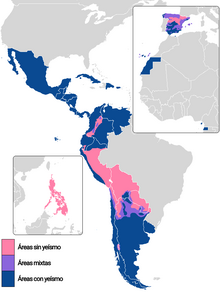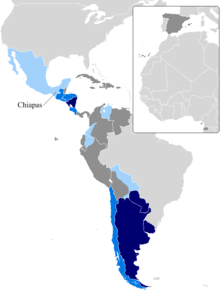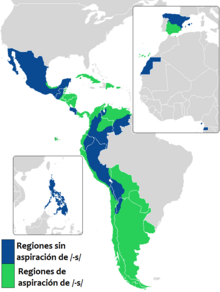| Paraguayan Spanish | |
|---|---|
| Español paraguayo | |
| Pronunciation | [espaˈɲol paɾaˈɣwaʝo] |
| Native to | Paraguay |
Native speakers | 6 million (2014)[1] |
Early forms | |
| Latin (Spanish alphabet) | |
| Official status | |
Official language in | |
| Regulated by | Academia Paraguaya de la Lengua Española |
| Language codes | |
| ISO 639-1 | es |
| ISO 639-2 | spa[2] |
| ISO 639-3 | – |
| Glottolog | None |
| IETF | es-PY |
Paraguayan Spanish (Spanish: español paraguayo) is the set of dialects of the Spanish language spoken in Paraguay. In addition, it influences the speech of the Argentine provinces of Misiones, Corrientes, Formosa, and, to a lesser extent, Chaco. Paraguayan Spanish possesses marked characteristics of the Spanish previously spoken in northern Spain, because a majority of the first Spanish settlers were from Old Castile and the Basque Country. In addition, there is great influence, in both vocabulary and grammar, from the Guarani language. Guarani is co-official with Spanish in Paraguay,[3] and most Paraguayans speak both languages.[4] Guaraní is the home language of more than half the population of Paraguay, with higher proportions of its use in rural areas, and those who speak Spanish at home slightly in the majority in the cities.[5] In addition to the strong influence of Guarani, Paraguayan Spanish is also influenced by Rioplatense Spanish due to the geographical, historical, and cultural proximity, as well as the sharing of features such as voseo, which is "the use of vos as a second-person singular pronoun."[6] Paraguayan Spanish is notable for its lack of yeísmo, meaning that the phonemes /ʎ/ (spelled ⟨ll⟩) and /ʝ/ (spelled ⟨y⟩) are distinguished.
The Swedish linguist Bertil Malmberg visited Paraguay in 1946 and observed several features of Spanish pronunciation that he attributed to Guaraní influence.[7] The Guaraní origin of many of these features, however, has been questioned by other researchers, who document them in dialects not in contact with Guaraní.[8]
The unique features of Paraguayan Spanish developed in part due to Paraguay's early isolation; for example, José Gaspar Rodríguez de Francia, the country's president until 1840, sealed Paraguay's borders. Other experiences with geographic, political, and economic isolation relative to its neighbours allowed Spanish spoken in Paraguay to develop its own unique characteristics, even apart from the wide-ranging influence of Guarani.[3]
Paraguay is, depending on the context, considered part of a region of South America known as the Southern Cone (Spanish: Cono Sur; Portuguese: Cone Sul). In its truest definition, the region consists of Chile, Argentina, and Uruguay, but can be expanded to include Paraguay and some regions of Brazil (Paraná, Rio Grande do Sul, Santa Catarina, and São Paulo). Excluding Brazil (where Portuguese is spoken), all the countries in that region have many similarities in vocabulary. Paraguayan Spanish shares many similarities with River Plate Spanish (that is, the variety spoken in Argentina and Uruguay) such as the use of the voseo and various words and phrases.


Typical Paraguayan Spanish has a strong influence from the sentence structure of Guarani as translated to Spanish, as well as the words and borrowed particles of Guarani for colloquial expressions. These are some common cases:

Due to the geographical and cultural proximity of Paraguay and Argentina, the two countries' dialects are often confused. In fact, along the border between Argentina and Paraguay, the local dialects of both countries have fused, creating a northeastern Argentine variety very similar to Paraguayan Spanish in the provinces along the border.[9] Examples:
Voseo is a peculiar characteristic of Paraguayan Spanish which is heavily influenced by the River Plate dialect (since historically in Paraguay Guarani was always spoken, and Spanish was relegated to the inhabitants of the capital or the most favored classes in the interior of the country). Another characteristic of voseo is how long it has been around for. "Voseo is the oldest form of Castilian Spanish". After the second half of the 20th century, the teaching of voseo depended on whether the teacher used vos or not. Adding to the strong Argentinian influence, either by the media or by the geographical and cultural proximity, voseo stayed as a distinctive characteristic of Paraguayan. Although it is rarely taught in schools today, voseo is beginning to regain some popularity in the form of an accepted regional dialect.
|
Main article: Andean Spanish |